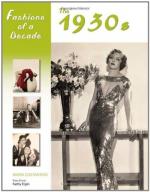|
This section contains 129 words (approx. 1 page at 300 words per page) |

|
A fundamental rule of fashion is that the cost of manufacturing a dress affects its appearance. Because the effects of the Depression were so far-reaching, cost became a consideration in dress design on all levels, from material to cut and decoration. Given the strict limits in which designers and couturiers worked, designers creatively used materials that had previously been overlooked or dismissed. Gone were the expensive excesses of the 1920s party dress, with its beaded and embroidered dresses and fragile silk jerseys, chiffons, and velvets. The Depression triggered a return to simple, ordinary fabrics. Evening wear now came in cotton varieties such as organdy, pique, and lace. Corduroy, boucle knit, and wool, once exclusively daytime materials, appeared as elegant night wear.
|
This section contains 129 words (approx. 1 page at 300 words per page) |

|




